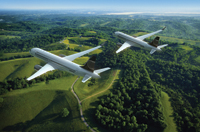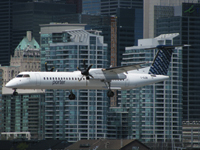
Features
Operations
Green with Energy
As with every area of human activity, aviation impacts the environment. This, of course, takes several forms, but it’s mainly disturbances caused by aircraft noise and engine emissions. Just how seriously is the aviation community impacting the environment?
July 6, 2011 By Peter Pigott
As with every area of human activity, aviation impacts the environment. This, of course, takes several forms, but it’s mainly disturbances caused by aircraft noise and engine emissions. Just how seriously is the aviation community impacting the environment? According to the United Nations Intergovernmental Panel on Climate Change (IPCC), the aviation industry produces two per cent of the world’s man-made emissions of carbon dioxide (CO2).
Through investment in new technology and operating procedures, the aviation industry has kept its emissions growth to three per cent, or some 20 million tonnes annually – and it’s achieved this rate even though passenger numbers are increasing at an average of 5.6 per cent annually. But as laudable as this is, a carbon footprint in this range is unacceptable in this, or any other, industry; there’s little doubt, serious change is needed.

|
“What might not be fully understood is how fast the concentration of carbon dioxide in the atmosphere is accumulating,” says Tim Leslie, supervisor of the National Research Council’s IAR Flight Research Laboratory in Ottawa. “We are simply creating CO2 at a greater rate than can be re-absorbed. Alarmists suggest this growth rate is exponential. I don’t quite interpret it this way – it strikes my scientific mind as more linear. Regardless of the actual shape of the slope, it is much steeper than it should be.”
Leslie maintains that there will soon come a time (in our lifetime, he estimates) when the Earth’s CO2 absorption capabilities will be overwhelmed. “And this is when a steep linear slope will actually become exponential and we may find ourselves creating an atmosphere not unlike that of Venus,” he says. “Our very existence as a species is at stake.”
A united front
With such an alarming prospect looming, it’s comforting to know corporate leaders in Canadian aviaiton are taking steps to find environmentally friendly solutions and processes for change. Such was the impetus for the development of the first annual “Fly Green – Making our Dreams a Reality” conference held Feb. 23 at the Canada Aviation and Space Museum in Ottawa. The event was the brainchild of the Green Aviation Research & Development Network (GARDN), a partnership between centres of excellence that brings together industry, university and government partners to lower noise and emissions pollution from the aerospace industry, and ultimately to reduce its ecological footprint.
Organized by Sylvain Cofsky, GARDN’s network manager, the event featured internationally renowned speakers from NASA, the International Civil Aviation Organization (ICAO), “Clean Sky,” ONERA (the French Aerospace Lab), and senior experts from Bombardier Aerospace, Bell Helicopter Textron Canada, Pratt & Whitney and Esterline CMC Electronics. The consensus from the experts in attendance was telling: to minimize the environmental impact that the anticipated growth in air traffic will have over the next 10 to 30 years, future aircraft designs will need to balance the reduction of community noise, greenhouse gases and manufacturing’s environmental footprint.
The conference kicked off with a poignant presentation from Dominic Collin, co-ordinator of the Aircraft Noise Research Network (X-Noise), who described the extensive noise reduction research programs in Europe and the challenges the sector faces in order to achieve its environmental goals. Collin pointed out that the effective mitigation of aviation noise could alleviate one of the bottlenecks to air traffic growth.
Professor David Zingg, director of the University of Toronto Institute of Aerospace Studies and Canada Research Chair in Computational Aerodynamics and Environmentally Friendly Aircraft Design, followed with an insightful presentation detailing the growing field of multidisciplinary optimization (MDO) and its applicability to the design of environmentally focused aircraft. Professor Zingg demonstrated how today’s MDO software tools allow aircraft designs to “converge” on highly aerodynamically efficient configurations to reduce fuel burn and therefore greenhouse gas emissions. Environmentally focused aircraft designs must of necessity consider the full life-cycle environmental footprint, he argued.
Gavin Campbell, director of Design Engineering & Technology Development at Bombardier Aerospace in Belfast, detailed the extensive efforts his company is making to design advanced materials and manufacturing processes that reduce life-cycle waste, reduce weight and improve efficiency of next-generation aircraft such as the Bombardier CSeries and Lear 85.
Campbell’s presentation, “Moving towards carbon neutral growth in the aviation sector: A perspective from the industry leaders,” detailed key elements aviation companies need to consider when developing aircraft of the future – elements that have been incorporated into the design of new Bombardier aircraft. Future initiatives, according to Campbell, must encompass:
- Uniformity of scale. Improvements in aircraft design is not the only area that contributes to carbon-neutral growth. There are three other areas to consider: operations, infrastructure and alternative fuels. All elements work together to contribute to overall improvements across the whole aviation system as well as in new products.
- Commitment to technology. For optimum results, balance is required. For example; the CSeries aircraft has a “game-changing” engine, but it also makes use of improved aerodynamics, advanced material use and the use of the latest generation in system technology. On their own, these improvements will not offer as much as when used together: this is what the CSeries “optimal aircraft integration” is all about. It produces a better overall reduction in fuel burn. Bombardier aircraft design teams have also made 70 per cent of the environmentally efficient CSeries jet with advanced structural materials, delivering significant weight savings. This has contributed to the CSeries’ 20 per cent fuel burn advantage.
- Operational requirements. From an operational standpoint, there are many factors an airline operator can consider. These include optimization of weight and load factors; the option of reducing speed and the amount of fuel carried; optimization of maintenance capabilities; engine handling and aircraft idling; the use of continuous descent approach; and flight planning accuracy.
- Understanding infrastructure. Aviation infrastructure is constantly improving. Both NextGen and the Single European Sky ATM Research Programme (SESAR) will ensure this happens within the air traffic control systems in both the United States and Europe by opening up more airspace to commercial carriers. This will allow for greater efficiencies in the system and will therefore contribute to further reduction of fuel burn.
- Biofuel enhancements. With the recent rapid development of biofuels within the aviation industry, this potentially will be the biggest gain in terms of reducing CO2 emissions if you consider the whole life cycle of biofuel. (For more on biofuels, see “A fuel of dreams,” pg. 16.)
- Deciphering the technology roadmap. With the co-ordination of research and development within the Canadian aviation industry through the Canadian Aviation Environmental Technology Roadmap (CAETRM), the Consortium for Research and Innovation in Aerospace in Quebec (CRIAQ) and the educational institutions, the Canadian aviation industry is well positioned to tackle the reduction of aircraft emissions and overall environmental impact of its future products.
A question of fuel management
Although careful consideration must be given to the processes and outcomes in the development of environmentally friendly aircraft, carefully monitoring the fuel that powers these aircraft is also crucial.
That’s precisely where companies like Montreal-based Esterline CMC Electronics come in. Esterline is a world leader in the development of environmental aerospace technologies. The company’s Flight Management System (FMS) recently achieved certification of airline standard Performance Vertical Navigation (VNAV), and can help to reduce an aircraft’s fuel consumption – and hence, a company’s carbon footprint.
“For the airlines, the overriding priority is efficiency and reducing harmful emissions,” says Rex Hygate, marketing and sales manager for Esterline CMC Electronics. “Almost half of the normal operating costs for an airline are in fuel. Consequently, technologies that maximize fuel efficiency in flight are extremely important.”

|
|
| The CSeries “optimal aircraft integration” includes its “game-changing” P&W engine, improved aerodynamics, advanced material use and the use of the latest generation in system technology.
|
The FMS is a flight deck computer that works to monitor fuel consumption. The pilot enters the flight plan into the FMS and the FMS then guides the autopilot both laterally and vertically. Performance VNAV continually optimizes the speed, altitude and descent path in order to minimize fuel, yet meets the schedule requirements of the flight. To accomplish this, the FMS holds a detailed airframe and engine flight model together with a detailed wind model. In cruise mode, it continually calculates the most efficient speed and optimum altitude as the aircraft burns fuel and becomes lighter. In descent, the FMS calculates the “Top of Descent,” and the exact descent path that meets the air traffic control constraints is determined – but burns the least fuel. The resulting path is called a “Continuous Descent Approach” or CDA.
Minimizing fuel also minimizes harmful CO2 and NOx emissions, Hygate adds. In addition, CDAs minimize airport vicinity noise. Currently, the company’s CMC’s CMA-9000 FMS, with performance optimization VNAV capability, is entering service on the Sukhoi SJ100 Russian Regional Jet.
Sustainability and climate change
A Sustainability and Climate Change Strategic Advisor at Pricewaterhouse-
Coopers (PwC) in Montreal, Janice Noronha has more than 17 years’ experience in developing sustainability and carbon strategic insights, reporting systems and frameworks in the transportation, metals, aerospace and mining sectors. Noronha remains optimistic the aviation community is taking the right steps in working to develop a greener environment.
“Over the past year, the aviation industry, both commercial and business aviation, came together to shape a common vision and goal to reducing its CO2 emissions,” she says. “Through this collaboration, the aviation industry has committed to a carbon-neutral growth objective, which means capping its emissions by 2020.”
Noronha maintains this rather ambitious goal could become challenging given that the aviation sector is expected to grow at a rate of 5.6 per cent per year until 2020, compared to a carbon-efficiency rate of less than one to two per cent per year.
But despite growth projections, the industry can get there, she contends. Through a well-defined carbon reduction roadmap, the sector is gearing itself towards even greater fuel efficiency in aircraft and engine technologies, while also investing in streamlined air traffic infrastructure and aircraft operating practices that eliminate unnecessary fuel burn. In fact, significant progress has been and continues to be made. Over the past four decades, fuel-efficiency increases of up to 70 per cent have been documented, and according to IATA (International Air Transport Association), improvements of a further 25 to 30 per cent by 2020 are expected. But, will this be enough to offset the industry’s growth rate? Noronha asks.
Post 2020, the roadmap relies on building even more efficient aircraft with additional technologies powered by non-carbon sources. Already, the level of industry investment, collaboration and progress in the successful testing and certification of second-generation biofuels is providing a positive outlook. The challenge, however, will be in the commercialization of these fuels as a truly cost-competitive option, Noronha says.
Questions around the future price of fossil fuels, coupled with political, social and demographic factors, contribute to the uncertainty surrounding alternative fuel usage. Despite legitimate concerns over the availability of fossil fuels, oil may continue to play a key role in the overall energy mix. The International Energy Agency anticipates that by 2030 fossil fuels will likely cover more than 85 per cent of energy needs, and even the most pessimistic estimates place the price of oil at around $200 per barrel. “Regardless, there appears little question of the importance of alternative fuels in not only helping the aviation sector to significantly reduce emissions but also in lessening its dependence on oil,” Noronha says.
A combined approach
As we wait for a clear alternative fuel option to emerge, the achievement of carbon-neutral growth objectives will hinge on a combination of technological and market-based measures, such as carbon offsets, Noronha maintains. Market-based systems will require accuracy, completeness, and transparency in carbon emissions data. Already, aircraft operators under the regional European Union Emission Trading Scheme are being subjected to necessary financial-level data controls and audit trails by third-party audit firms. These types of verifications will also be important when making carbon-efficiency claims on aviation product attributes.
At a global level, ICAO continues to play an integral role in moving the sector towards an international framework. Just recently at its 37th Assembly, ICAO defined its guiding principles for setting up market-based measures for international aviation, focusing on a transparent, cost-effective and administratively simple solution that minimizes carbon leakage, market distortions and duplication in accounting for global CO2 emissions.
“With consensus on these guiding principles, there will be a movement toward an international market-based mechanism that would enable carbon offsetting,” Noronha says. “Such a mechanism will be critical in meeting the aviation industry’s carbon-neutral growth commitments in the short term, while hedging on alternative fuels for the long term.”
No silver bullet
If the aviation community is to reach its goal of significantly reducing the amount of CO2 in the atmosphere, serious work needs to be done – and now – says the NRC’s Leslie. “Not factoring in the very real consideration of reducing carbon dioxide emissions ignores an important reality,” he says. “There are plenty of organizations scrambling to resolve the big issues like creating biofuels and modifying aircraft design. I am so very glad they are.”
Leslie maintains a greater commitment to R&D from smaller companies right on up to the major players in the industry, is critical to achieving the ultimate goal. “If we don’t make small changes as individuals the major players simply don’t stand a chance at solving the big issues through R&D,” he says. “In my view there is no one silver bullet here; rather, it will be a combined effort of R&D as well as looking for efficiencies whenever and wherever
we can.”
Change makers
Global aviation firms are making real strides in developing ways to achieve carbon-neutral growth, reduce fuel consumption and be more environmentally responsible. Leading initiatives that stand out include:
|
